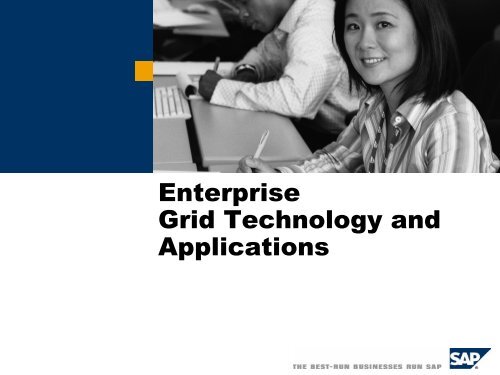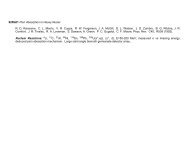Enterprise Grid Technology and Applications - PNPI Home Page
Enterprise Grid Technology and Applications - PNPI Home Page
Enterprise Grid Technology and Applications - PNPI Home Page
You also want an ePaper? Increase the reach of your titles
YUMPU automatically turns print PDFs into web optimized ePapers that Google loves.
<strong>Enterprise</strong><br />
<strong>Grid</strong> <strong>Technology</strong> <strong>and</strong><br />
<strong>Applications</strong>
Contributing Speaker(s)<br />
Dr. Alex<strong>and</strong>er Gebhart<br />
Development Manager <strong>Enterprise</strong> <strong>Grid</strong> Computing, SAP<br />
Erol Bozak<br />
Architecture <strong>Enterprise</strong> <strong>Grid</strong> Computing, SAP<br />
© SAP AG 2004, SAP TechEd / CI204 / 2
Introduction<br />
Internet Pricing <strong>and</strong> Configurator (CRM: IPC)<br />
Advanced Planner <strong>and</strong> Optimizer (SCM: APO)<br />
Workforce Management (CRM: WFM)<br />
Summary<br />
Q&A<br />
Divider <strong>Page</strong> Section 7<br />
Divider <strong>Page</strong> Section 8
Learning Objectives<br />
As a result of this workshop, you will<br />
be able to:<br />
• Assess the benefits you will gain with <strong>Grid</strong> Computing<br />
• Know how grid-enabled SAP applications work<br />
• Get an impression of the SAP <strong>Grid</strong> strategy<br />
© SAP AG 2004, SAP TechEd / CI204 / 4
Why <strong>Grid</strong> Computing<br />
• TCO reduction<br />
• Performance increase<br />
• Ease of use (installation, customizing, removal)<br />
• Future-proof<br />
• Growing amount of information<br />
• Hardware evolution<br />
• Greater dem<strong>and</strong>s for efficiency<br />
• St<strong>and</strong>ards-based<br />
• Integral part of SOA architectures<br />
© SAP AG 2004, SAP TechEd / CI204 / 5
<strong>Grid</strong> <strong>Technology</strong> Evolution<br />
‣ <strong>Grid</strong> <strong>Technology</strong><br />
• Dynamic, on-dem<strong>and</strong><br />
resource allocation<br />
• Resource awareness<br />
• Virtual Computing<br />
System<br />
• Tools to h<strong>and</strong>le<br />
distributed resources<br />
‣ Service Oriented<br />
Architecture<br />
• Usually Web Services<br />
based<br />
• St<strong>and</strong>ard <strong>Technology</strong><br />
• Static resource<br />
allocation<br />
+<br />
‣ <strong>Grid</strong> Services<br />
• Dynamic, on-dem<strong>and</strong><br />
Web Services<br />
• Resource-aware<br />
Web Services (QoS)<br />
• St<strong>and</strong>ards-based<br />
(WSRF, OGSA)<br />
• St<strong>and</strong>ard services for<br />
distributed SOA systems<br />
(Toolkit)<br />
© SAP AG 2004, SAP TechEd / CI204 / 6
Impact on ESA<br />
Static ESA<br />
Dynamic ESA<br />
Client<br />
Client<br />
Client<br />
Client<br />
Client<br />
Client<br />
Client<br />
Client<br />
Client<br />
Client<br />
Client<br />
Client<br />
Client<br />
Client<br />
Client<br />
Client<br />
Client<br />
Client<br />
QoS<br />
QoS<br />
QoS<br />
<strong>Grid</strong> Services Management<br />
CREATE / MEDIATE<br />
<strong>Enterprise</strong><br />
Service<br />
<strong>Enterprise</strong><br />
<strong>Enterprise</strong><br />
Service<br />
Service<br />
<strong>Enterprise</strong><br />
Service<br />
<strong>Enterprise</strong><br />
<strong>Enterprise</strong><br />
Service<br />
Service<br />
<strong>Enterprise</strong><br />
Service<br />
<strong>Enterprise</strong><br />
<strong>Enterprise</strong><br />
Service<br />
Service<br />
<strong>Enterprise</strong><br />
Service<br />
<strong>Enterprise</strong><br />
<strong>Enterprise</strong><br />
Service<br />
Service<br />
<strong>Enterprise</strong><br />
Service<br />
<strong>Enterprise</strong><br />
<strong>Enterprise</strong><br />
Service<br />
Service<br />
<strong>Enterprise</strong><br />
Service<br />
<strong>Enterprise</strong><br />
<strong>Enterprise</strong><br />
Service<br />
Service<br />
Cluster A Cluster B <strong>Grid</strong> Pool C<br />
Cluster A Cluster B <strong>Grid</strong> Pool C<br />
© SAP AG 2004, SAP TechEd / CI204 / 7
SAP <strong>Grid</strong> Architecture Overview<br />
<strong>Grid</strong>-enabled SAP <strong>Applications</strong><br />
Participation in <strong>Grid</strong> St<strong>and</strong>ardization<br />
IPC APO WFM … …<br />
. . .<br />
...<br />
SAP <strong>Grid</strong> Middleware<br />
Higher-level <strong>Grid</strong> Services<br />
(e.g. Regulator Service, Lifecycle Management, …)<br />
Lower-level <strong>Grid</strong> Services<br />
(Deployment, Logging, Tracing, …)<br />
Programming Model & Cookbook<br />
Globus Toolkit<br />
© SAP AG 2004, SAP TechEd / CI204 / 8
Introduction<br />
Internet Pricing <strong>and</strong> Configurator (CRM: IPC)<br />
Advanced Planner <strong>and</strong> Optimizer (SCM: APO)<br />
Workforce Management (CRM: WFM)<br />
Summary<br />
Q&A<br />
Divider <strong>Page</strong> Section 7<br />
Divider <strong>Page</strong> Section 8
SAP Internet Pricing <strong>and</strong> Configurator (IPC) Overview<br />
Web Browsers / Batch Processes<br />
(typically several thous<strong>and</strong> requests)<br />
Request:<br />
Price Query<br />
2<br />
IPC<br />
Server<br />
1<br />
IPC<br />
Dispatcher<br />
Delegation of<br />
Request<br />
2<br />
Response: Pricelist<br />
Depending on:<br />
-Time<br />
- Discount<br />
- Number of Items<br />
-…<br />
3<br />
IPC<br />
Server<br />
© SAP AG 2004, SAP TechEd / CI204 / 10
IPC Scenarios<br />
‣ Scenario I: Too few IPC server applications<br />
• Result: Bad user experience<br />
‣ Scenario II: Too many IPC server applications<br />
• Result: Unnecessarily high TCO<br />
‣ <strong>Grid</strong>-enabled scenario:<br />
Right number of IPC server applications<br />
© SAP AG 2004, SAP TechEd / CI204 / 11
Demo<br />
Demo<br />
© SAP AG 2004, SAP TechEd / CI204 / 12
<strong>Grid</strong> IPC: TCO Reduction by Less Server Components<br />
A<br />
B<br />
1<br />
1<br />
Traditional scenario<br />
for two departments:<br />
20 Servers<br />
10<br />
10<br />
A<br />
1 2<br />
1<br />
8<br />
B<br />
1 2<br />
<strong>Grid</strong>-enabled scenario<br />
for two departments:<br />
12 Servers<br />
© SAP AG 2004, SAP TechEd / CI204 / 13
<strong>Grid</strong> IPC: Performance Increase<br />
A<br />
B<br />
1<br />
1<br />
Traditional scenario<br />
for two departments:<br />
10 Servers Each<br />
10<br />
10<br />
A<br />
1 2<br />
1<br />
B<br />
1 2<br />
<strong>Grid</strong>-enabled scenario<br />
for two departments:<br />
18 Servers Each<br />
16<br />
© SAP AG 2004, SAP TechEd / CI204 / 14
<strong>Grid</strong> IPC: TCO Reduction by Ease of Use<br />
• Automatic IPC deployment via drag&drop<br />
• Automatic OS detection (Unix / Windows<br />
platform)<br />
• Central STOP comm<strong>and</strong> removes IPC<br />
installation completely<br />
• Advanced monitoring capabilities<br />
© SAP AG 2004, SAP TechEd / CI204 / 15
Introduction<br />
Internet Pricing <strong>and</strong> Configurator (CRM: IPC)<br />
Advanced Planner <strong>and</strong> Optimizer (SCM: APO)<br />
Workforce Management (CRM: WFM)<br />
Summary<br />
Q&A<br />
Divider <strong>Page</strong> Section 7<br />
Divider <strong>Page</strong> Section 8
SCM Optimization<br />
Measure<br />
Supply Chain Performance Management<br />
Supplier<br />
Supply<br />
Chain<br />
Hub<br />
Network<br />
Partner<br />
Collaborate<br />
Supply Chain Collaboration<br />
Strategize<br />
Plan<br />
Dem<strong>and</strong> <strong>and</strong><br />
Supply Chain Design<br />
Supply Planning<br />
Source<br />
Make<br />
Deliver<br />
Direct<br />
Order<br />
Manufacturing<br />
Procurement<br />
Fulfillment<br />
Supply Chain Collaboration<br />
Collaborate<br />
Customer<br />
Supply<br />
Chain<br />
Hub<br />
Network<br />
Partner<br />
Supply Chain Event Management<br />
Track<br />
© SAP AG 2004, SAP TechEd / CI204 / 17
Optimization Process<br />
Setup times in<br />
paint shop<br />
Prod. A B C<br />
A 0 10 20<br />
B 30 0 10<br />
C 40 30 0<br />
Setup time in<br />
minutes<br />
Product A: white color<br />
Product B: yellow color<br />
Product C: blue color<br />
Customer orders<br />
<strong>and</strong> due dates<br />
A<br />
C<br />
B<br />
A<br />
20 30 30<br />
time<br />
A<br />
Setup<br />
C<br />
Setup<br />
B<br />
Setup<br />
A<br />
A<br />
Optimal plan for setup<br />
10 10<br />
A<br />
B<br />
C<br />
A<br />
Optimal plan for setup <strong>and</strong> due dates<br />
10 10 40<br />
Set-<br />
Setup<br />
Setup<br />
Setup<br />
B up C<br />
Setup<br />
A<br />
© SAP AG 2004, SAP TechEd / CI204 / 18
APO Overview<br />
Optimization<br />
Request<br />
1<br />
APO<br />
Slave<br />
2<br />
APO<br />
Master<br />
Request Split<br />
Optimization<br />
Result<br />
3<br />
2<br />
APO<br />
Slave<br />
© SAP AG 2004, SAP TechEd / CI204 / 19
APO Overview (cont.)<br />
‣ Traditional setup:<br />
APO running on one dedicated machine with<br />
fixed number of optimization processes<br />
‣ New grid-enabled setup:<br />
APO running on multiple machines with optimal<br />
number of optimization processes<br />
© SAP AG 2004, SAP TechEd / CI204 / 20
Demo<br />
Demo<br />
© SAP AG 2004, SAP TechEd / CI204 / 21
Summary <strong>Grid</strong>-enabled APO<br />
• Get better optimization results<br />
• E.g. lead time reduction of ONE BUSINESS WEEK<br />
possible<br />
• Dynamic usage of available resources<br />
• Ease of use<br />
• Automatic deployment <strong>and</strong> removal of all APO<br />
components (master <strong>and</strong> slaves)<br />
© SAP AG 2004, SAP TechEd / CI204 / 22
Introduction<br />
Internet Pricing <strong>and</strong> Configurator (CRM: IPC)<br />
Advanced Planner <strong>and</strong> Optimizer (SCM: APO)<br />
Workforce Management (CRM: WFM)<br />
Summary<br />
Q&A<br />
Divider <strong>Page</strong> Section 7<br />
Divider <strong>Page</strong> Section 8
What is Workforce Management<br />
Ability to optimally deploy human resources with the right skills,<br />
right place at the right time<br />
Application Scenarios<br />
• Contact centers, hotels, police stations,<br />
banks, fast food restaurants, department stores,<br />
airlines, distribution centers, etc.<br />
Why is Workforce Management important to these scenarios<br />
• They operate more efficiently, from reducing labor law violations to<br />
bottom line reduction in payroll costs<br />
• Improvements in customer service/care<br />
• Improvements in staff morale & retention<br />
What is the Challenge<br />
• Scheduling/optimization problem with a variety of<br />
competing objectives <strong>and</strong> constraints<br />
• Customer needs, staff needs <strong>and</strong> performance,<br />
company policy & legal regulations etc.<br />
© SAP AG 2004, SAP TechEd / CI204 / 24
Scheduling <strong>and</strong> Optimization<br />
1. Schedule dem<strong>and</strong><br />
2. Schedule Filler Work &<br />
smooth dem<strong>and</strong><br />
3. Schedule Employees to<br />
dem<strong>and</strong> & filler work<br />
4. Optimize Employee schedules within<br />
rules & constraints, minimize costs<br />
© SAP AG 2004, SAP TechEd / CI204 / 25
WFM Overview<br />
Calculation<br />
Request<br />
1<br />
Request<br />
Manager<br />
Queue<br />
2<br />
Dispatch<br />
Solver<br />
Engine<br />
Calculation<br />
Result<br />
3<br />
2<br />
Solver<br />
Engine<br />
© SAP AG 2004, SAP TechEd / CI204 / 26
WFM Overview (cont.)<br />
‣ Traditional setup:<br />
Static amount of WFM solvers for one work queue<br />
‣ New grid-enabled setup:<br />
Adapted number of WFM solvers depending on size<br />
of work queue<br />
© SAP AG 2004, SAP TechEd / CI204 / 27
Demo<br />
Demo<br />
© SAP AG 2004, SAP TechEd / CI204 / 28
Summary <strong>Grid</strong>-enabled WFM<br />
• Get results faster<br />
• Significant reduction of your waiting time by using<br />
idle resources<br />
• Dynamic usage of available resources<br />
• Ease of use<br />
• Automatic deployment <strong>and</strong> removal of WFM<br />
components<br />
© SAP AG 2004, SAP TechEd / CI204 / 29
Introduction<br />
Internet Pricing <strong>and</strong> Configurator (CRM: IPC)<br />
Advanced Planner <strong>and</strong> Optimizer (SCM: APO)<br />
Workforce Management (CRM: WFM)<br />
Summary<br />
Q&A<br />
Divider <strong>Page</strong> Section 7<br />
Divider <strong>Page</strong> Section 8
Summary<br />
<strong>Grid</strong> Services enable a dynamic ESA…<br />
Client<br />
Client<br />
Client<br />
Client<br />
Client<br />
Client<br />
Client<br />
Client<br />
Client<br />
QoS<br />
QoS<br />
QoS<br />
<strong>Grid</strong> Services Management<br />
CREATE / MEDIATE<br />
<strong>Enterprise</strong><br />
Service<br />
<strong>Enterprise</strong><br />
<strong>Enterprise</strong><br />
Service<br />
Service<br />
<strong>Enterprise</strong><br />
Service<br />
<strong>Enterprise</strong><br />
<strong>Enterprise</strong><br />
Service<br />
Service<br />
<strong>Enterprise</strong><br />
Service<br />
<strong>Enterprise</strong><br />
<strong>Enterprise</strong><br />
Service<br />
Service<br />
Cluster A Cluster B <strong>Grid</strong> Pool C<br />
© SAP AG 2004, SAP TechEd / CI204 / 31
Summary (cont.)<br />
TCO reduction / performance increase with<br />
NEW grid-enabled SAP software<br />
• Better results in less time<br />
• Flexible usage of idle (low-cost) resources<br />
• Ease of use<br />
• Automatic installation, customizing <strong>and</strong> removal<br />
• Autonomic capabilities<br />
© SAP AG 2004, SAP TechEd / CI204 / 32
Summary (cont.)<br />
Future Proof<br />
• St<strong>and</strong>ards-based (WS, OGSA, WSRF, Globus Toolkit)<br />
• Part of ESA<br />
More grid-enabled<br />
applications upcoming…<br />
© SAP AG 2004, SAP TechEd / CI204 / 33
Questions<br />
Q&A<br />
© SAP AG 2004, SAP TechEd / CI204 / 34
Copyright 2004 SAP AG. All Rights Reserved<br />
• No part of this publication may be reproduced or transmitted in any form or for any purpose without the express<br />
permission of SAP AG. The information contained herein may be changed without prior notice.<br />
• Some software products marketed by SAP AG <strong>and</strong> its distributors contain proprietary software components of other<br />
software vendors.<br />
• Microsoft, Windows, Outlook, <strong>and</strong> PowerPoint are registered trademarks of Microsoft Corporation.<br />
• IBM, DB2, DB2 Universal Database, OS/2, Parallel Sysplex, MVS/ESA, AIX, S/390, AS/400, OS/390, OS/400, iSeries,<br />
pSeries, xSeries, zSeries, z/OS, AFP, Intelligent Miner, WebSphere, Netfinity, Tivoli, <strong>and</strong> Informix are trademarks or<br />
registered trademarks of IBM Corporation in the United States <strong>and</strong>/or other countries.<br />
• Oracle is a registered trademark of Oracle Corporation.<br />
• UNIX, X/Open, OSF/1, <strong>and</strong> Motif are registered trademarks of the Open Group.<br />
• Citrix, ICA, Program Neighborhood, MetaFrame, WinFrame, VideoFrame, <strong>and</strong> MultiWin are trademarks or registered<br />
trademarks of Citrix Systems, Inc.<br />
• HTML, XML, XHTML <strong>and</strong> W3C are trademarks or registered trademarks of W3C®, World Wide Web Consortium,<br />
Massachusetts Institute of <strong>Technology</strong>.<br />
• Java is a registered trademark of Sun Microsystems, Inc.<br />
• JavaScript is a registered trademark of Sun Microsystems, Inc., used under license for technology invented <strong>and</strong><br />
implemented by Netscape.<br />
• MaxDB is a trademark of MySQL AB, Sweden.<br />
• SAP, R/3, mySAP, mySAP.com, xApps, xApp, SAP NetWeaver <strong>and</strong> other SAP products <strong>and</strong> services mentioned herein<br />
as well as their respective logos are trademarks or registered trademarks of SAP AG in Germany <strong>and</strong> in several other<br />
countries all over the world. All other product <strong>and</strong> service names mentioned are the trademarks of their respective<br />
companies. Data contained in this document serves informational purposes only. National product specifications may vary.<br />
• These materials are subject to change without notice. These materials are provided by SAP AG <strong>and</strong> its affiliated<br />
companies ("SAP Group") for informational purposes only, without representation or warranty of any kind, <strong>and</strong> SAP Group<br />
shall not be liable for errors or omissions with respect to the materials. The only warranties for SAP Group products <strong>and</strong><br />
services are those that are set forth in the express warranty statements accompanying such products <strong>and</strong> services, if any.<br />
Nothing herein should be construed as constituting an additional warranty.<br />
© SAP AG 2004, SAP TechEd / CI204 / 35







